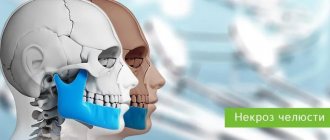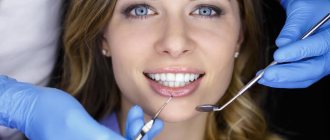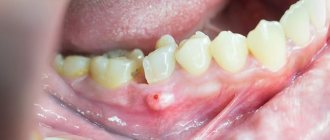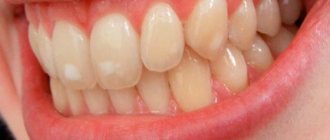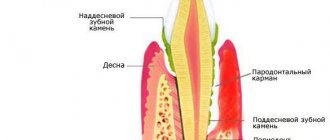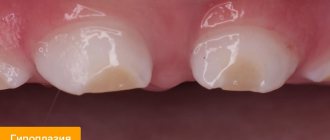Gangrenous pulpitis is a putrefactive inflammation of the pulp in the crown and root parts of the tooth, which is accompanied by the death of its tissues. This form is considered one of the most dangerous and neglected, and its characteristic feature is the destruction of the pulp.
Gangrenous pulpitis of the tooth
is a late stage of chronic pulpitis, resulting from the lack of treatment for a disease such as caries. It is characterized by such unpleasant manifestations as darkening of the tooth, the development of halitosis (bad breath), and aching pain symptoms. Most often, this form of pulpitis affects the chewing teeth of the lower jaw.
Filling made of light-curing material for classes I and V - 2,000 rubles.
Filling made of light-curing material in classes II, III, IV - 3,000 rubles.
Placing a temporary filling - 400 rubles.
Resection of the root apex (frontal group) - 6,500 rubles.
Resection of the root apex (chewing group) - RUB 9,000.
Mechanical and medicinal treatment of canals for periodontitis (1 canal) - 1,100 rubles.
Closing perforations (MTA) - RUB 6,500.
At CELT you can get advice from a dental specialist.
- The cost of a dental consultation is 1,000
- The cost of an orthodontist consultation is 2,000
Make an appointment
Gangrenous pulpitis: etiology
Gangrenous pulpitis occurs due to the penetration of putrefactive anaerobic bacteria into the pulp. At the same time, the routes of penetration can be different:
- A carious cavity that requires treatment;
- Incorrectly carried out treatment, in which the affected tissues reached the nerve of the tooth (pulpitis develops under the filling);
- Violations of the technique of preparing a tooth for a crown;
- Deep periodontal pockets;
- Destruction of the tooth to soft tissues with severe abrasion;
- Periodontitis of the adjacent tooth;
- Various tooth injuries;
- Diseases of an infectious nature in which microorganisms are transferred to dental tissues through blood and lymph.
Another reason for the development is exacerbation of gangrenous pulpitis
, which was not cured and over time developed into a chronic form.
Symptoms
Symptoms of gangrenous pulpitis depend on the form in which it occurs:
- Acute gangrenous pulpitis is characterized by the presence of deep ulcers that cover the entire pulp. Due to the destruction of the septum between the carious cavity and the pulp, the infection penetrates inside. The acute form is characterized by severe pain that occurs for no reason or as a result of a reaction to irritants in the form of hot or cold food;
- Chronic gangrenous pulpitis is characterized by a dirty-gray tint of the upper layers of the pulp and the tooth itself, and the presence of a large carious cavity. There is no bleeding. There are practically no symptoms of pain, but sometimes aching pain may occur, especially when exposed to irritants. There is a putrid odor from the mouth.
The course of the disease depends on the following factors:
- pathogenicity of microorganisms;
- pulp resistance;
- the patient's general health status;
- periodontal condition;
- body resistance;
- the presence of concomitant pathologies.
This means that the process of development of the disease directly depends on how healthy the patient’s body is: the stronger it is, the more time it takes for bacteria to have a negative effect. Taking into account the above, we can conclude that the disease is especially severe in children, since the resistance of the child’s body is much lower than that of an adult. Clinic of gangrenous pulpitis
may vary depending on whether the tooth cavity is open or closed. So, with an open cavity, the following symptoms are observed:
| Symptoms of an open cavity | Symptoms with a closed cavity |
|
|
Pulpitis: definition, causes, signs, consequences
Pulpitis is an inflammation of the pulp that occurs due to the entry of one or another infection into it through the crown of the tooth (intradental infection) or through the apical foramen located at the apex of the tooth (retrograde infection). Most often, pulpitis is a consequence of long-term caries.
But there are other factors that provoke the appearance and development of this disease. Modern dentistry divides them into 3 main groups:
Physiological ones include overheating of the pulp and/or accidental opening of the dental cavity during preparation, fracture of the coronal part with opening of the pulp chamber, the presence of decalcified formations in the pulp - calcifications (denticles and petrification), which, deposited in it, irritate the nerve endings, compress the blood vessels, disrupt blood flow, cause swelling, discomfort and pain.
Chemical factors include iatrogenic factors caused by doctor errors during the treatment process: the use of strong antiseptic solutions for treating a carious cavity, incomplete removal of the etching gel, etc.
Biological factors include factors that create conditions for infection to enter the pulp: secondary caries, spread of infection from the carious cavity along the dentinal tubules, retrograde pulpitis, when the infection enters the pulp through the apical foramen in sepsis, osteomyelitis, through the lateral branches of the root canal - in periodontitis (after curettage).
The most common symptom of pulpitis is an intractable throbbing pain as a reaction to one or another irritant: temperature, chemical (eating sweet food), mechanical (brushing teeth, etc.). Such pain does not go away on its own, and painkillers often do not help. However, such pain is characteristic not only of pulpitis, but also of other diseases. Therefore, if pain occurs, it is very important to immediately contact your dentist to determine the cause of the pain and begin treatment. If the disease is not treated, the inflammatory process becomes more intense and spreads to the periodontium, resulting in periodontitis. Remember: acute toothache requires immediate consultation with a doctor, without attempting self-medication.
Gangrenous pulpitis in children
Children are much less susceptible to this disease... However, if it occurs, its treatment requires considerable effort. Most often, young patients suffer from chronic pulpitis due to the fact that they cannot correctly explain the essence of the problem and the nature of the pain. This leads to the disease becoming chronic. According to dentists, gangrenous pulpitis in childhood develops as a result of fibrous and purulent forms of pulpitis, occurring in a chronic or acute form, respectively. Necrosis of the tooth nerve begins as a result of the penetration of anaerobic microflora into it, while pain symptoms are determined by the peculiarities of the baby’s nervous system. During the examination, the dentist identifies large carious cavities and dead pulp tissue. Painful symptoms occur when probing the canal openings. For treatment, it is most often necessary to use a devital method of removing the nerve of the tooth.
Complications of pulpitis
Untimely treatment of acute pulpitis leads to a chronic process. A hidden infectious focus is formed in the body, which can provoke the appearance of both new dental diseases and general ailments, such as:
- flux - periostitis, purulent inflammation of the periosteum,
- osteomyelitis - inflammation of the bone tissue of the jaw,
- purulent inflammatory processes of intraoral tissues and soft tissues of the face,
- dental cyst - a benign neoplasm near the tips of the roots,
- sepsis - blood poisoning,
- The infection spreads to other organs through the bloodstream, with the heart and kidneys most often affected.
These diseases will require surgical or general systemic treatment - in no case should they be allowed to appear.
Diagnosis of the disease
Treatment of gangrenous pulpitis is prescribed only after the dentist makes the correct diagnosis. It is very important to be able to distinguish this disease from:
- deep caries;
- chronic fibrous pulpitis;
- apical periodontitis.
A visual examination of the oral cavity by a dentist reveals the following:
- deep carious cavity with softened dentin;
- open dental cavity;
- grayish coating on the upper layers of the pulp;
- change in the color of the tooth crown.
Probing the pulp can be painful, in contrast to percussion, in which there are practically no pain symptoms.
In addition to a visual examination, the doctor will prescribe:
- X-ray diagnostics;
- electroodontodiagnostics.
Reviews about our doctors
I would like to express my gratitude to the dentist Elena Nikolaevna Kiseleva and her assistant Svetlana - they are real specialists and at the same time sensitive, not burnt out by years of practice.
Thanks to them, I have been coming back here for many years. Thanks to the management for such doctors! Read full review Svetlana Nikolaevna
13.08.2021
I am very grateful to Evgeniy Borisovich Antiukhin for removing my three eights. Especially considering that the lower tooth was not the simplest (it was located in an embrace with a nerve). The removal took place in 2 stages, one tooth under local anesthesia, two under general anesthesia. I had no idea that wisdom teeth could be... Read full review
Sofia
28.12.2020
Treatment of gangrenous pulpitis
Unfortunately, treatment of acute and chronic gangrenous pulpitis
It is carried out only by surgical techniques. They involve removing the nerve of the tooth, since the process of its damage is irreversible. The procedure is performed under local anesthesia and requires complete removal of the pulp from the root and crown parts of the tooth. In order for it to proceed correctly, it is necessary to exclude bleeding. To do this, the dentist performs cauterization of the vessels. Once the pulp has been removed, one of two solutions is used:
- the canals are cleaned and sealed, and a permanent filling is applied;
- obturation is performed using calcium hydroxide and temporary filling.
Since the disease is often accompanied by severe destruction of the crown part of the tooth, it may require the installation of an artificial crown to restore it.
Treatment methods for pulpitis
All methods of treating pulpitis can be divided into two main ones - biological, aimed at treating and restoring the pulp, and surgical, involving its partial or complete removal in order to preserve the tooth. Only a qualified dentist can determine which method to use in each specific case based on a thorough diagnostic examination.
The biological method is a method of conservative treatment, with the help of which the inflammatory process is eliminated and the pulp retains its viability. Thus, the affected pulp is subjected to alkalization, after which secondary dentin begins to be produced again. The biological method is effective only if the patient comes to the dentist immediately after the onset of a pain symptom. Treatment of pulpitis with a biological method is more effective in people at a young age (up to 30 years), when the pulp is capable of self-healing, in the absence of chronic diseases and sufficient caries resistance (resistance to caries). The treatment follows the following algorithm: the pulp is opened, treated with an antiseptic solution, a bandage with calcium hydroxide is applied on top, the cavity is closed with a temporary filling, which after some time is replaced with a permanent one.
The biological method is quite complex to perform and requires high professionalism of the attending physician. In general, this technique is characterized by low predictability of a positive treatment outcome. And even with extensive clinical experience, this method is not always effective. Because of these reasons, this treatment method is not very popular, and often doctors, bypassing it, immediately proceed to a more radical and predictable surgical method of treating pulpitis.
The surgical method consists of removing the affected pulp, cleaning the canals, sanitation from infection and subsequent filling of the tooth canals. The surgical method combines several techniques.
Amputation is prescribed in cases of acute pulpitis or accidental trauma to the pulp and involves removing the coronal part of the pulp while maintaining the viability of its root section. This technique is only suitable for treating pulpitis of multi-rooted teeth. Amputation can be vital (“life-saving”) - this is when part of the “dental nerve” is removed immediately under anesthesia. In this case, a necessary condition for the operation is a completely healthy periodontium. And devital (“life stopping”) - when the pulp is mummified using a special paste. After this, one section of the “dental nerve” is removed, and the second is mummified so that in the future this part does not become a source of recurrence of pulpitis. This technique is used extremely rarely in clinical practice, since this method is quite controversial and the possibility of relapse cannot be excluded. Therefore, for more effective treatment of pulpitis, a more radical method of treating pulpitis is often used - extirpation.
Extirpation
is the complete removal of the pulp when it is impossible to maintain its viability. Extirpation, just like amputation, is of two types - vital and non-vital. During vital extirpation, which is performed under anesthesia in one visit, the pulp is not mummified before being removed from the cavity. The dentist removes carious dental tissue, then penetrates the canals using special thin needles and removes the affected “dental nerve,” after which he treats the cavity with antiseptics. This technique is used for all forms and stages of pulpitis.
During devital extirpation, the pulp is first mummified using a paste containing arsenic, paraformaldehyde or another substance with a similar effect. On single-rooted teeth, the paste should remain for at least 24 hours, on multi-rooted teeth - at least 48. Some mild pastes can be left on for 7-14 days. The tooth cavity is closed with a temporary filling. After the paste expires, the doctor removes the pulp, cleans the canals and installs a permanent filling.
Using the devital extirpation method, pulpitis can be cured in 2–3 visits, depending on the number of roots in the diseased tooth. Devital extirpation is suitable for the treatment of all types and stages of pulpitis except purulent and necrotic, and is also not used in the treatment of baby teeth. With the development of technology, this method in modern dentistry is also becoming less popular and, perhaps, can be found in remote areas from regional centers.
The final stage of endodontic tooth treatment is filling (obturation) of the tooth canals, which requires a highly qualified doctor. Regardless of what method of vital or devital extirpation the pulp is removed, special attention is paid to filling the canals. After all, the main task is to prevent periodontal infection. Obturation of the root canal of a tooth can be carried out using the following methods - filling with one paste without pins and using gutta-percha pins in various variations, filling using heated gutta-percha with its vertical compaction, on a carrier (thermophile), using the “System B” device, a combined technique , or filling with gutta-percha from a syringe. The choice of methodology and materials always remains with the attending physician based on his preferences, clinical experience, level of training and capabilities of the clinic.
After all medical manipulations with the tooth have been completed, the final step is the application/installation of a permanent filling in accordance with aesthetic, individual and clinical characteristics.
Attention:
A temporary filling that closes the tooth cavity, where the active “dental nerve-killing” substance is located in the root canals, can be very durable and can last for several months. In this case, the pain that bothered him goes away and the patient does not experience any discomfort, and therefore postpones the next visit to the doctor indefinitely. Remember, in no case should such drugs be allowed to remain in the pulp chamber for a longer period than was determined by the doctor. You must come to the dental office on the appointed date and complete your treatment!
Also, every patient must remember and know that it is mandatory to attend a follow-up appointment after depulpation, strictly on the day prescribed by the attending physician. Since the patient himself is unable to independently distinguish the normal physiological state of the tooth after treatment of pulpitis from the pathological one.
Treatment prognosis and disease prevention
Dentists at the CELT clinic give favorable prognoses for treatment that was carried out efficiently and on time. In any case, they take all measures to save the tooth.
In order to avoid this disease and keep the tooth healthy, it is necessary to undergo preventive examinations at the dentist every six months and not try to endure toothache. The earlier the disease is detected, the easier and faster it can be cured. Prevention measures also include maintaining oral hygiene. The dental department of the CELT clinic offers services for the treatment of the most complex cases of gangrenous pulpitis. Contact us and be healthy!
Make an appointment through the application or by calling +7 +7 We work every day:
- Monday—Friday: 8.00—20.00
- Saturday: 8.00–18.00
- Sunday is a day off
The nearest metro and MCC stations to the clinic:
- Highway of Enthusiasts or Perovo
- Partisan
- Enthusiast Highway
Driving directions
Clinical researches
Repeated clinical studies have proven that regular use of preventive toothpaste ASEPTA ACTIVE for a month can reduce bleeding gums by 60%, improve the overall condition of the oral cavity by 44% and reduce inflammation by 33%.
Sources:
- Clinical and laboratory assessment of the influence of domestic therapeutic and prophylactic toothpaste based on plant extracts on the condition of the oral cavity in patients with simple marginal gingivitis. Doctor of Medical Sciences, Professor Elovikova T.M.1, Candidate of Chemical Sciences, Associate Professor Ermishina E.Yu. 2, Doctor of Technical Sciences Associate Professor Belokonova N.A. 2 Department of Therapeutic Dentistry USMU1, Department of General Chemistry USMU2
- Clinical experience in using the Asepta series of products Fuchs Elena Ivanovna Assistant of the Department of Therapeutic and Pediatric Dentistry State Budgetary Educational Institution of Higher Professional Education Ryazan State Medical University named after Academician I.P. Pavlova of the Ministry of Health and Social Development of the Russian Federation (GBOU VPO RyazSMU Ministry of Health and Social Development of Russia)
- Report on determining/confirming the preventive properties of toothpaste “ASEPTA PLUS” COFFEE and TOBACCO Author: doctor-researcher A.A. Leontyev, head Department of Preventive Dentistry, Doctor of Medical Sciences, Professor S.B. Ulitovsky. First St. Petersburg State Medical University named after. acad. I.P. Pavlova, Department of Preventive Dentistry
